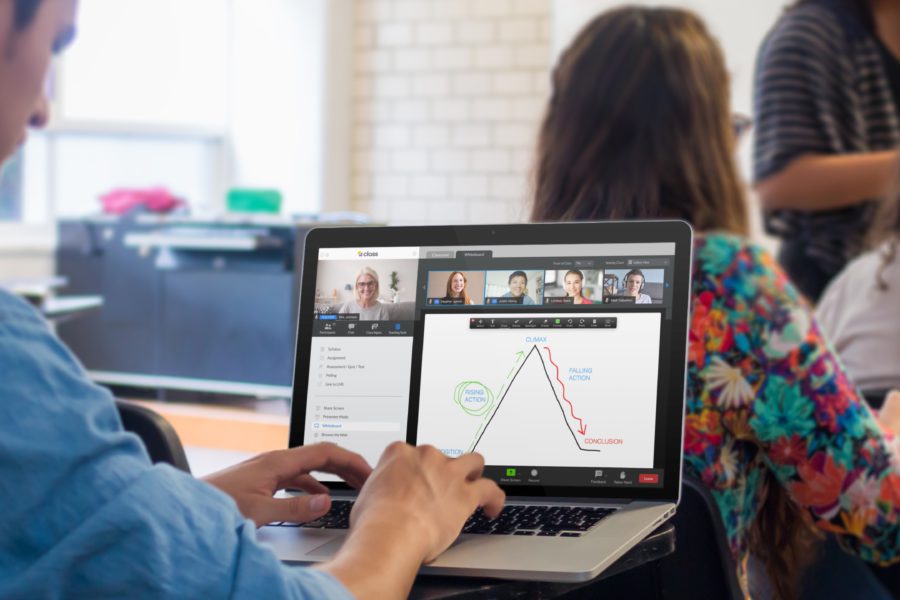
Class is the next generation virtual classroom for K-12, higher education, government agencies, and the workplace. Contact us today to schedule your live demo and see Class in action.

Class is the next generation virtual classroom for K-12, higher education, government agencies, and the workplace. Contact us today to schedule your live demo and see Class in action.

It’s clear that learning will look different even after concerns about COVID-19 have diminished. Two new terms that we frequently hear these days are “hybrid” and “blended learning.” What are they? What is the difference between hybrid and blended learning?
Educators and administrators are already thinking about what fall 2021 will look like for K12 schools and how they can prepare for hybrid and blended learning. We want to take a deep dive into the meaning behind these terms and how educators are currently using them and planning to implement them for the upcoming fall semester.
David Egolf is Head of School at Corlears School in Manhattan. As a school leader, he finds the topic very interesting and says he understands the differentiation between blended and hybrid from the standpoint of one being “more pedagogical” and the other “more structural.”
What is blended learning? “Blended learning is when students have an integrated learning experience that flows from online to in-person instruction, providing complementary learning experiences that each take advantage of the benefits of the strengths within each approach,” Egolf says. This is in relationship to instructional design and using the right tool for the right element of building understanding.
Hybrid learning, says Egolf, “refers to the structure of students learning partially online and partially in-person.” It’s the model that many schools are currently following to help them achieve flexibility while allowing students to have opportunities for in-person instruction.
Still, despite a logical distinction, many use these terms interchangeably, says Diane Hirshberg, professor of education policy at the Institute of Social and Economic Research at the University of Alaska Anchorage. What both hybrid and blended learning have in common, says Hirshberg, is the need for reliable technology: “robust internet access, computers or tablets in the home, etc. — and more importantly, educators who are trained to teach in these ways.”
She says she has seen “hybrid” used to describe learners who may either be online or in-person. Blended, she says, “means that I will use a combination of teaching strategies, where students engage in both in-person and online activities and the online instruction may be synchronous or asynchronous.” In addition, she says, “blended can also mean a fully online course that includes both synchronous and asynchronous instruction and activities.”
Egolf says that at Corlears, because it is a small school with a low-density environment in terms of the number of children within a given space, “we were able to offer full time, everyday instruction to all students, as well as provide a virtual classroom option for those who preferred.” Consequently, he says, the school isn’t using hybrid learning. However, he says, blended learning is occurring both in in-person and virtual classroom environments.
“For us, blending learning is used to support growth in students’ learning independence,” Egolf says. “So, a student in an in-person or a virtual cohort might utilize an online tool such as DreamBox to explore and reinforce concepts that were introduced during small group instruction at their own independent pace.”
Blended learning provides that option to meet a wider array of student learning styles and preferences, offering flexibility and autonomy that students find very engaging.
Successful online, blended, or hybrid teaching, says Hirschberg, is a skill that not many educators have had formal training in. They haven’t specifically been coached in how to teach a hybrid class. Her hope, she says, is that districts use some of their federal relief funds over the summer “to invest in professional development for teachers on effective blended and online teaching, as well as in giving educators time to plan their classes.”
There wasn’t enough time last summer to do that, Hirschberg says, and some districts may be paying the price now. K-12 teaching, especially, she says, requires time to develop because it is “far more intensive and time-consuming.”
Teachers, says Hirschberg, “need to be supported both in terms of having support from online education experts and technology professionals for the redesign of their classes and in terms of being compensated for the time to do this well.” Districts, she says, “also need to assure that families are set up to facilitate learning this way.” And, she adds: “They need to reach out in particular to less privileged families to assure they have adequate bandwidth and technology at home.” If they don’t, she says, districts need to figure out how to make that bandwidth and technology available. If not, she predicts, “we will continue to see students disengage and fall further behind.”

Ronald Auerbach is an educator who has taught on campus, fully online and using blended and hybrid models. These are models, he says, that can be used in public schools, in colleges or universities and even in corporate training. While hybrid and blended learning have a role to play across all levels of learning, even at the corporate level, Auerbach believes that children in elementary schools will do best when they’re able to take part in classroom-based learning.
“At their age and social development, the physical contact, need to be physically around others, hands-on nature of kids, and individualized attention is best provided when you’re physically in a classroom,” Auerbach says. In addition, he says, attention spans at this level aren’t as long as they may be with older students. Some level of classroom learning, he believes, is important—even if it’s just for a few days a week.
Like Hirschberg, Auerbach points to lack of preparation on the part of many districts and support for their teachers to learn how to teach in this new environment is an issue that has led to a “rough transition.” Yet, he says: “I will say that despite things not being the ideal, public schools and their students have done the best they could under the circumstances.”
Betty Norton, an educator for more than 20 years and head of school for Xceed Anywhere, an accredited virtual middle and high school, shares some best practice ideas for evaluation and consideration by teachers and administrators discussing blended and hybrid learning as a new school year approaches.
Schools, parents and students have learned a lot over the past year, but everyone is still asking “what is hybrid learning in school?” This year, Auerbach believes, hybrid and blended learning “will become easier and more efficient.” Teachers will be more comfortable with the online teaching technologies and have more experience; students will be more comfortable in this blended learning environment. “Students, even in elementary schools, are very resilient and understanding,” he says.
Despite the steep learning curve and massive disruption school systems have experienced over the past year, Auerbach says: “I am very confident that public schools all across the country have been taking appropriate measures to get themselves ready for hybrid/blended learning.”

Class is the next generation virtual classroom for K-12, higher education, government agencies, and the workplace. Contact us today to schedule your live demo and see Class in action.

Class is the next generation virtual classroom for K-12, higher education, government agencies, and the workplace. Contact us today to schedule your live demo and see Class in action.
Get our insights, tips, and best practices delivered to your inbox

Sign up for a product demo today to learn how Class’s virtual classroom powers digital transformation at your organization.

Features
Products
Integrations